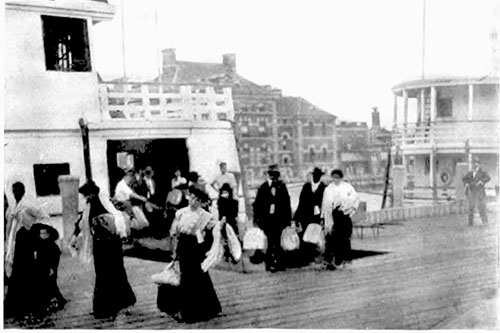Immigrant Types at Ellis Island

Immigrants Landing at Ellis Island., Public Hygiene, Vol. 2, 1911. | GGA Image ID # 1548377dbd
Each immigrant brings America an individual correlation of the wishes which rule human conduct. In one, the desire for recognition predominates; in another, the desire for security; and so on, in many variations. This individual organization of wishes is what we all call character.
Likewise, each immigrant group brings a more or less marked character. And while we do not ignore that character is partly due to temperamental qualities -- the characteristics of the Swedes, the Jews, and the Italians, may be connected with their original, inborn, temperamental dispositions.
It is nevertheless confident that character in both individuals and groups is mainly built up by the process which we have referred to above as "the definition of the situation" -- by gossip, conversation, disputes, doctrines, by the whole of the experiences and social influences which modify, qualify, and organize the wishes.
Therefore, we can distinguish roughly various immigrant types, representing different heritages. It is not valid, however, that we can treat any given immigrant group strictly en bloc from the standpoint of heritage.
Explore Immigrant Types through period articles written from the viewpoint of when this significant influx of immigration and immigrants was happening.
The Immigrant, Past and Present - Dr. Allan McLaughlin (1904)
After the Peace of Paris in 1783 and the birth of a new nation on the American continent, home-seekers arriving at ports of the United States were called immigrants. Previous to the revolutionary war, they were known as colonists. The distinction is one of political allegiance.
No one can read the report for 1904 of the Commissioner General of Immigration, Frank P. Sargent, without being seriously impressed with the laxity of our present immigration laws and the urgent need for more stringent regulation of our immigration.
The Character of Our Immigration, Past and Present (1904)
We have no right to oppose needful measures of legislative relief out of sympathy for the sufferings of the people, thus seeking admission to our shores or out of respect to the traditions which up to now have caused this country to be regarded as an asylum.
Immigration - What It Means (1907)
And I tell you, my friends, that it is humane to legislate and to enforce the law to discourage, if not forbid, the emigration of the unfit and undesirable. It is wise legislation that says to a man before he leaves home.
The Boon of Immigration to the United States (1907)
But a million immigrants means 300.000 of these men. If each worker represents a loom, a small ship, an engine, or a house, costing $10,000 and producing $500 a year.
The Economic and Social Value of Immigrant Woman (1907)
Immigrant women, quite as much as immigrant men, belong to the exploited and disinherited group, and though we flatter ourselves that women are better protected than men, immigrant women upon their arrival.
A Million Immigrants A Year (1908)
In hard times the tide sinks; in prosperous times, it rises. Our present great prosperity has rolled it up to practically a million a year, this year probably considerably more than a million.
Immigration Notes From Commissioner Robert Watchorn (1908)
The immigration problem is a problem only when the immigrants are dealt with in mass. It resolves itself into a straightforward situation when we meet them as individual men and individual women, splendidly equipped with the same natural endowments which we claim.
Immigration Trends and the Role of Christian Missions (1908)
Not only are the newcomers different from their predecessors and more illiterate,—there are more of them. The year 1882 marked the high tide of the old immigration.
The Evangelization Of Foreign-Speaking Immigrants (1908)
We must come to close quarters immediately with the theme assigned to us, which is a discussion of the specific part to be borne by the individual church in evangelizing foreign-speaking immigrants.
The Protection of Immigrant Women (1908)
Considering the many disadvantages and dangers, it is remarkable how many come through safely and become honest, hard-working women and law-abiding citizens.
Our Immigrants And The Future (1912)
Too much emphasis has perhaps been laid in recent widespread discussions on the increase in the number of immigrants.
Our Foreign Born Citizens (1917)
Not long ago, America crossed the hundred-million line in the number of its citizens. When all these have been deducted from the 100,000,000, only 54,000,000 remain of full white native ancestry.
